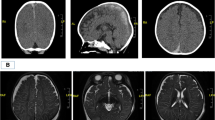Abstract
Ischaemic cerebral accidents are frequent following extracorporeal membrane oxygenation (ECMO), especially after fixing the reinjection cannula in the right primitive carotid artery, which leads to an interruption in downstream flow. We describe a rare and unusual symptom of cerebral ischaemic accident that is known as Capgras syndrome. This feature is interesting because it may be documented by computed tomography (CT) scan and particular electroencephalography signals. It appears that our observation represents the first documented case of Capgras syndrome complicating ECMO. This incident emphasizes the potential hazards associated with right common artery ligature for venoarterial extracorporeal membrane oxygenation (VAECMO). In addition, it shows that this psychiatric symptom (that has been interpreted psychodynamically for many years) can have an organic basis, which should be studied.


Similar content being viewed by others
Abbreviations
- CT:
-
CT = computed tomography
- ECMO:
-
ECMO = extracorporeal membrane oxygenation
- ICA:
-
ICA = internal carotid artery
- PLED:
-
PLED = periodic lateralized epilepti-form discharge
- VAECMO:
-
VAECMO = venous arterial extracorporeal membrane oxygenation.
References
Evrard S, Bousser MG: Watershed cerebral infarcts [in French]. Sang Thrombose Vaisseau 1991, 3: 103-108.
Bogousslavsky J, Salvador A: The Capgras syndrome [in French]. Ann Méd Psychol 1981, 139: 949-964.
Samson E, Picard S: The Capgras syndrome. Can J Psychiatry 1986, 31: 142-145.
Bogousslavsky J: Major syndromes of the minor hemisphere [in French]. Encycl Med Chir 1991, 17022: E10,6.
Debruille J, Stip E: Capgras syndrome: evolution of the hypotheses [in French]. Can J Psychiatry 1996, 41: 181-187.
Silva JA, Leong GB: The Capgras' syndrome in paranoid schizophrenia. Psychopathology 1992, 25: 147-153.
Ellis H: The role of right hemisphere in the Capgras delusion. Psychopathology 1994, 27: 177-185.
Collins MN, Hawthorne M: Capgras' syndrome with organic disorders. Postgrad Med J 1990, 66: 1064-1067.
Weston MJ, Whitlock FA: The Capgras syndrome following head injury. Br J Psychiatry 1971, 119: 25-31.
Chawla HM, Virmani V: Capgras phenomenon in a case of temporal lobe epilepsy. Folia Psychiatr Neurol Jpn 1977, 31: 615-617.
Rodichok L, Winters J, Myers J, Schwentker M, Marshall W: The evolution of EEG changes during extracorporeal circulation and progressive hypothermia with or without circulary arrest. Am J EEG Technol 1994, 34: 66-74.
Campbell LR: Significance of seizures associated with extracorporeal membrane oxygenation. J Pediatr 1991, 119: 789-792.
Emilio C: The significance of periodic lateralized epileptiform discharge in EEG: an electrographic clinical and pathological study. Electroencephalogr Clin Neuropsychol 1964, 17: 177-193. 10.1016/0013-4694(64)90149-X
Schwartz MS, Prior P, Scott DF: The occurrence and evolution in EEG of lateralized periodic phenomenom. Brain 1973, 96: 613-622.
Schraeder PL, Singh N: Seizure disorders following periodic lateralized epileptiform discharges. Epilepsia 1980, 21: 647-653.
Leblanc R, Yamamoto YL, Tyler JL, Diksic M, Hakim A: Borderzone ischemia. Ann Neurol 1987, 22: 707-713.
Lewis M, Wierner , Berry GR: Intracranial circulation in carotid occlusion. Arch Neurol 1964, 11: 167-171.
Nornes H: The role of the circle of Willis in graded occlusion of the internal carotid artery in man. Acta Neurochirurg 1973, 28: 165-177.
Hardesty W, Roberts B, Toole JF: Studies of carotid artery blood flow in man. N Engl J Med 1960, 10: 944-946.
Author information
Authors and Affiliations
Corresponding author
Rights and permissions
About this article
Cite this article
Dejode, J.M., Antonini, F., Lagier, P. et al. Case report: Capgras syndrome: a clinical manifestation of watershed cerebral infarct complicating the use of extracorporeal membrane oxygenation. Crit Care 5, 232 (2001). https://doi.org/10.1186/cc1029
Received:
Accepted:
Published:
DOI: https://doi.org/10.1186/cc1029




